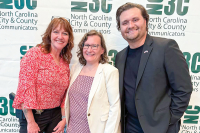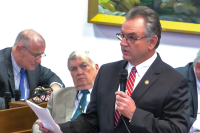Lake Junaluska navigates choppy political waters
Ron Clauser never saw himself as a lobbyist. He’s an accountant by trade, a world where logic and rationale rule the day. The same could be said of Ed LaFountaine, a career military man and retired major general in the airforce.
Higher cost for new restrooms at Waynesville playground could nix project
Renovating the antiquated, shuttered restrooms at the Waynesville Recreation Park will cost more than town officials anticipated, leaving them to question whether to bother or just scrap the plans altogether.
To busk or not? Waynesville ponders street performer ordinance
Street musicians are becoming a common sight in downtown Waynesville, despite a town policy that bans sidewalk performers from playing for tips.
Big trucks take heed: no more Jake brakes in Waynesville
Waynesville has outlawed the use of noisy engine-compression brakes by big trucks.
Neighbors plead their case to put the brakes on quarry expansion
Neighbors near a towering rock quarry in Waynesville have voiced concerns over a proposed expansion that could cause excavations to creep ever closer to their homes.
Lake Junaluska merger bill off the table indefinitely
A state bill that would have merged Lake Junaluska with the town of Waynesville is dead for now.
Frog Level auction house hopping mad over Waynesville sign rules
 A new fixture made an appearance on the sidewalks of Frog Level last week: a giant green frog waving and mugging for motorists as they tooled through this small business district on the outskirts of downtown Waynesville.
A new fixture made an appearance on the sidewalks of Frog Level last week: a giant green frog waving and mugging for motorists as they tooled through this small business district on the outskirts of downtown Waynesville.
Passel of new patrol cars on Waynesville’s shopping list
The town of Waynesville plans to buy 15 new police cars in the coming year for $500,000, a move that will assign each officer their own vehicle instead of having to share.
Taco Bell to find new home on South Main
Waynesville’s South Main Street continues to see slow but steady commercial growth, with a Taco Bell and Mattress Firm soon to join the ranks of the growing retail corridor.
With merger in limbo, Waynesville budget sent back to the drawing board
The Waynesville Board of Aldermen rubberstamped a $31.8 million budget Monday, but it may just have to turn right around and approve a new one.





